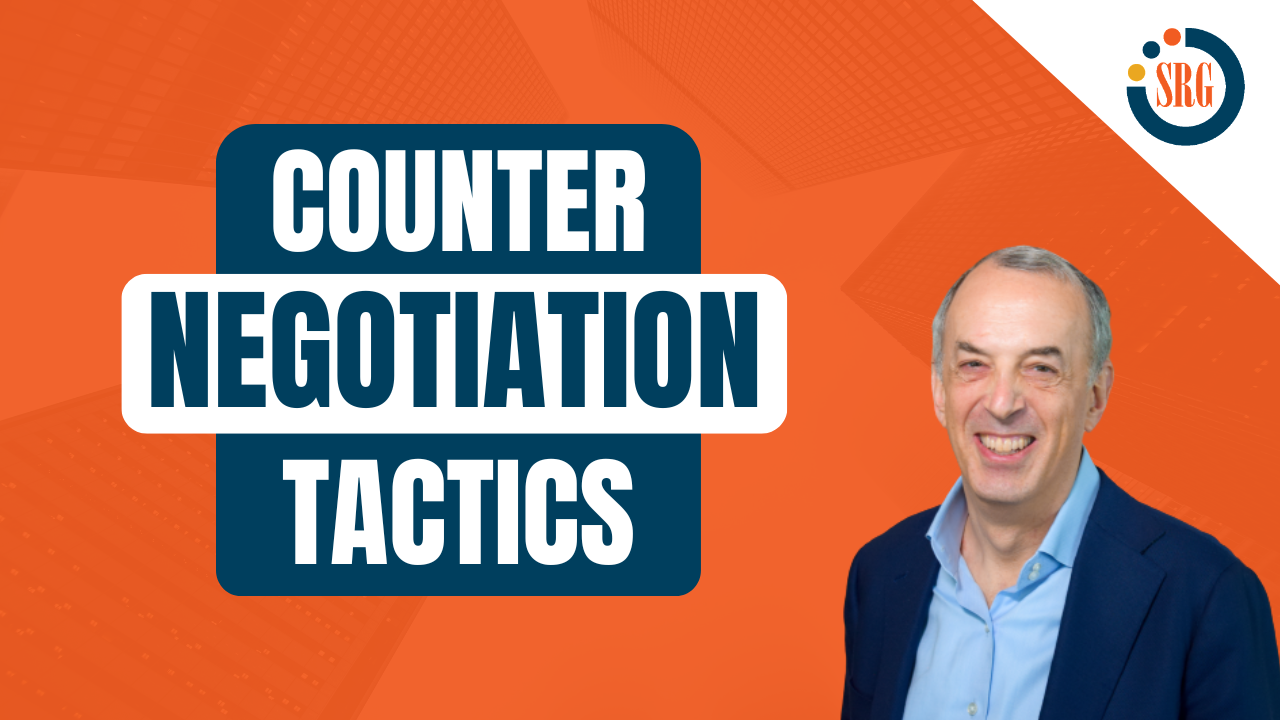Counter Negotiation Tactics to Use When Buyer Makes the First Offer


One frequently discussed issue by negotiation experts is when you should make the first offer in a negotiation. Conventional wisdom is to never make the first offer in a negotiation. After all, by making the first offer, you risk "showing your cards" too early and leaving money on the table. On the other hand, there are many cases where it is to your advantage to make the first offer. So how do you know?
Why Is the First Offer So Important?
The benefit of making the first offer is that it acts as an anchor. Anchoring in negotiation is a well-documented cognitive bias that describes the human tendency to rely too heavily on the first piece of information offered (the "anchor") when making decisions.
A classic case of anchoring is the sticker price of a new car. It is common knowledge that the price you pay for a car is less than the price on the window sticker. So why do car dealerships even bother posting the sticker price? The answer is simple: anchoring.
The initial price, whether we like it or not, tends to act as an anchor or reference point for all subsequent price discussions, biasing our expectations subconsciously and shifting the negotiation toward the higher end of your price range.
For example, assume you are willing pay $18,000 to $19,000 for a car. You go to a car dealership and see that the sticker price is $20,000, but then after some negotiating, the salesperson offers to sell it to you for $19,000. Because of the anchoring effect, you will be convinced you are getting a much better deal than if the car was initially priced at $19,000.
7 Tips to Set a Price Anchor
Setting a price anchor strategically can significantly influence the outcome of a negotiation. When you make the first offer, you can establish a reference point that shapes the rest of the discussion. Here is how to negotiate price by setting an anchor:
- Know your range: Determine your desired price range before entering a negotiation. Understand the minimum price you are willing to accept and the maximum price you believe is justifiable.
- Research and preparation: Conduct thorough research on the market, industry standards, and your specific offering. Consider factors such as the value you provide, the quality of your product or service, and any unique selling propositions.
- Consider the buyer's perspective: Put yourself in the buyer's shoes and consider their potential expectations and perceptions. How might they evaluate the value of your offering? Understanding their perspective will enable you to position your anchor more effectively.
- Be confident and assertive: Project confidence and assertiveness when making the first offer. This attitude can influence the perception of your credibility and expertise, affecting how the buyer responds to your anchor.
- Justify your anchor: Support your anchor with logical reasoning and facts. Explain the value and benefits the buyer will receive at the proposed price. Demonstrate a solid understanding of their needs and how your offering meets them.
- Avoid extreme positions: While setting an anchor that favors your position is essential, avoid being overly aggressive or unreasonable. Extreme positions can create resistance and lead to an unproductive negotiation. Instead, strive for a balance that allows for meaningful discussion and flexibility.
- Maintain flexibility: Remember that negotiation is a dynamic process. Flexibility shows your willingness to find mutually beneficial solutions and helps build trust with the buyer. Be prepared to adjust your anchor based on new information or insights gained during the negotiation.
Should You Always Make the First Offer?
So, given the power of an anchor, isn't it always better to make the first offer? In fact, no.
Sometimes letting the other party make the first move is better. The danger of going first is that you could start with a price less than the other side's willingness to pay. In this case, you have inadvertently anchored the negotiations to the other side's "lowball" price.
The deciding factor on whether to go first in a negotiation is how much information you have regarding the other side's willingness to pay. If you have sufficient information about the other side's willingness to pay, go first to avoid being anchored. But if you have little information about the other side's willingness to pay, let the other side open the negotiations and collect more information.
Counter Negotiation Tactics for the Buyer's First Offer
In many cases, based on your lack of information regarding the other side's willingness to pay, the conventional wisdom is correct: don't make the first offer. The risk, however, is that you may fall for the effects of anchoring.
Here are five counter-negotiation tactics that you can use to help protect yourself from the worst effects of a buyer's anchor:
Tactic 1: Ignore the Anchor
When confronted with an aggressive opening position from the buyer, it is crucial not to respond directly by suggesting agreement or disagreement. The best approach is to deflect the anchor and show that you acknowledge their opening. By doing so, you create space for further negotiation.
For example, you can respond by saying, "... I think we may be looking at this contract renewal in very different ways. Let's try and find some common ground by discussing..."
This response lets you shift the focus away from the initial offer and regain control of the negotiation.
Tactic 2: Counter-Anchor
Another effective tactic is to quickly counter-offer to offset the anchoring effect created by the buyer's first offer. By presenting your counter-anchor, you establish a new starting point that aligns more favorably with your position.
For instance, if the buyer suggests a ten percent discount, you can respond, "Actually, we just implemented a five percent price increase on all contract renewals based on our increased costs."
This response addresses the buyer's offer and introduces a new perspective that works in your favor.
Tactic 3: Separate Leverage from Information
Every buyer's opening offer typically contains elements of leverage and information. Buyers tell you what they want (information) and why you should accept it (leverage). It is essential to carefully listen and distinguish between the two, especially when the buyer takes an extreme position.
For example, if the buyer says, "XYZ Corp has offered the same thing for 20% less," it is important not to dwell solely on their implicit demand for a discount. Instead, redirect the conversation to how your offering can differentiate itself from the competition.
Tactic 4: Clarify
Sometimes, the most effective response to a buyer's attempt to anchor is to ask clarifying questions rather than immediately counter-anchoring. By probing for more information regarding the buyer's position and motivations, you gain a deeper understanding of their needs and can develop creative options to offer later in the discussions.
Don't hesitate to seek clarification if you are unsure about the buyer's intentions. You can ask questions like, "Could you go over that again?" or "I am not sure what it is you are asking for..." By clarifying their position, you can better address their concerns and negotiate from a position of understanding.
After asking clarifying questions, don’t dwell on the buyer's anchor and change the subject. This is crucial because their anchor is designed to keep you focused on their agenda, not yours. You can maintain control and explore mutually beneficial solutions by changing the subject and moving the conversation forward.
Tactic 5: Reject the Anchor
Finally, if the buyer's position is so extreme that it is far outside your planned positions, you must be prepared to say that this opening position is not even a basis for negotiating. In other words, you tell the buyer you reject their anchor. Naturally, you must back this position up with one or two reasons and propose an acceptable negotiation basis (Counter-Anchor).
In any negotiation, thorough preparation and research are essential to determining when to make the first offer. If you let the buyer go first and make the first offer, it is essential that you manage the effects of anchoring in negotiation. To avoid the effects of anchoring or using them to your advantage, you must first understand your buyer and their willingness to pay.
Key Takeaways
When dealing with the buyer's first offer, it is important to employ effective counter-negotiation tactics. These tactics include ignoring the anchor, counter-anchoring with your offer, separating leverage from information, asking clarifying questions, and, if necessary, rejecting the anchor outright.
By utilizing these tactics, you can navigate the negotiation process more effectively and mitigate the influence of the buyer's initial offer. Thorough preparation, understanding the buyer's willingness to pay, and maintaining conversation control is key to achieving successful outcomes.
Remember, negotiation is a skill that can be developed and refined over time. Mastering these counter-negotiation tactics can enhance your negotiation abilities and reach mutually beneficial agreements.
If you want to improve your team's negotiating skills, our Value-Driven Negotiating training program will equip your sales professionals to counter difficult buyer negotiation tactics.
💬 Join the Conversation
Got any other ideas for negotiating when the buyer goes first? Share your tips and experiences here.
